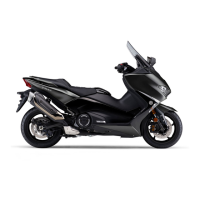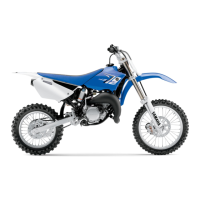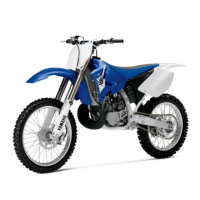
Do you have a question about the Yamaha Lexi ABS GDS125-A and is the answer not in the manual?
| Displacement | 124.7 cc |
|---|---|
| Bore x Stroke | 52.0 mm x 58.7 mm |
| Compression Ratio | 11.2:1 |
| Fuel System | Fuel Injection |
| Ignition System | TCI |
| Starting System | Electric |
| Lubrication System | Wet sump |
| Transmission | V-Belt Automatic |
| Ground Clearance | 133 mm |
| Seat Height | 785 mm |
| Frame Type | Underbone |
| Front Suspension | Telescopic Fork |
| Rear Suspension | Unit Swing |
| Rear Brake | Drum |
| Front Tire | 90/90-14M/C 46P |
| Rear Tire | 100/90-14M/C 57P |
| Max Torque | 11.3 Nm @ 7000 rpm |
| Fuel Tank Capacity | 4.2 L |
| Wheelbase | 1, 350 mm |
| Front Brake | Disc |
Essential owner duties and safe riding techniques for scooter operation.
Guidelines for wearing appropriate protective clothing and helmets.
Warnings about carbon monoxide poisoning and safe operation.
Advice on using genuine vs. aftermarket parts and modifications.
Information on aftermarket tires, rims, and proper scooter transportation.
Tips for safe riding, including signaling and hazard awareness.
Identification and location of key components on the left side of the vehicle.
Identification and location of key components on the right side of the vehicle.
Overview of handlebar controls, levers, and the instrument panel.
Explains the smart key system's functions and basic operation.
Details on smart key operating range, handling, and security precautions.
Covers replacing the smart key battery and main switch functions.
Explains how the Stop and Start System works to save fuel and reduce emissions.
Step-by-step guide on activating, stopping, and restarting the engine with the system.
Explains the meaning and function of various dashboard indicator and warning lights.
Details on the meter unit, its various displays, and modes.
Description of various switches and controls on the handlebars.
Information on brake levers, lock, and the ABS system.
Covers fuel tank cap, fuel type, and the catalytic converter.
Information on helmet holders, power outlet, sidestand, and ignition cut-off.
Procedures for starting the engine and safely beginning to ride.
Guidance on acceleration, deceleration, braking, and fuel saving.
Instructions for engine break-in periods and safe parking procedures.
Information on the tool kit and periodic maintenance schedules.
Procedures for checking and changing engine oil and cleaning the oil strainer.
Guidelines for tire pressure, inspection, and cast wheel care.
Procedures for checking brake fluid, changing fluid, and pad/shoe wear.
Guidance for diagnosing and resolving common problems with smart key and Stop/Start systems.
Steps to address engine overheating and operate the vehicle in emergency mode.
Instructions for cleaning the scooter, including matte finishes and specific warnings.
Recommendations for short-term and long-term storage of the scooter.
Recording vehicle and engine serial numbers for reference and identification.
Information on the vehicle's ECU data storage for diagnostics and research.











